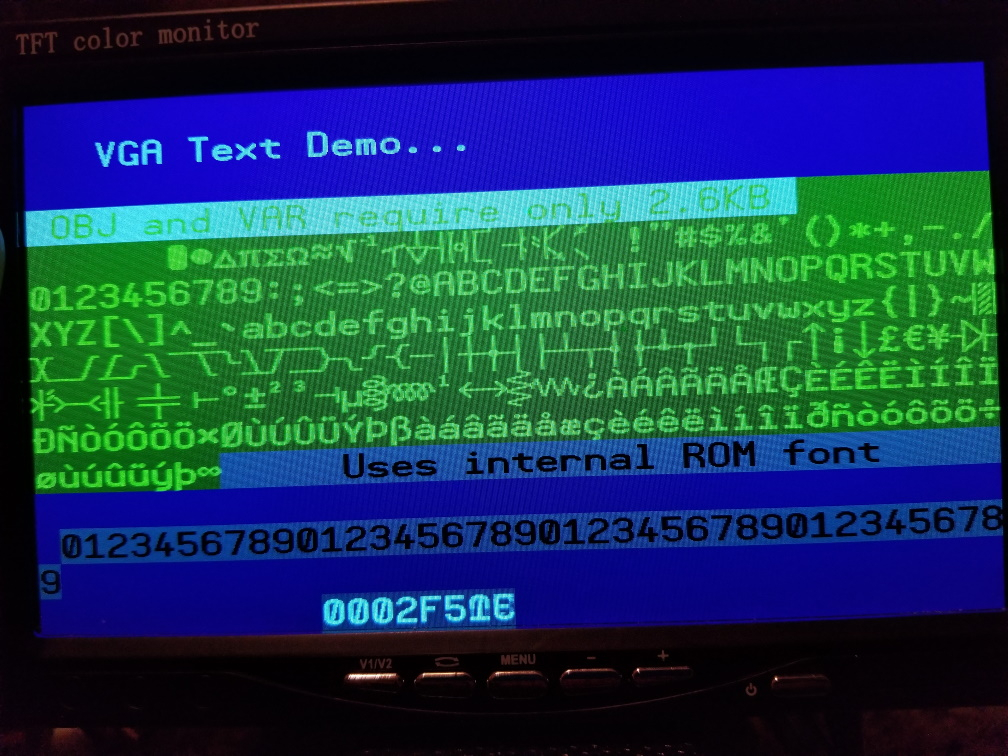VGA_Text_Demo for 6.25 MHz crystal
This is a pretty obvious thing to do, but not 100% sure I've seen it and can't find it anywhere...
Anyway, if you replace the standard 5 MHz crystal with a 6.25 MHz crystal, you can get real 640x480 resolution with the normal 25 MHz dot clock.
This increases rows from 32 to 40, visible horizontal pixels from 512 to 640, pixel clock from 20 to 25 MHz.
This is set by "text.start(8)" for a basepin of 8. You may need to change this to 16 or something to match your hardware setup.
Unfortunately, I can't find a 6.25 MHz crystal to test this out with. But, I'm testing on a P1V in fpga and pretty sure it's good.
If someone can see it work with a real P1, please let me know.



Comments
There is spare blanking time. It could be reduced and still be fine with a CRT. 6.00 MHz crystals are far more common than 6.25 MHz. The below should be suitable for 6.00 MHz (24 MHz dot clock):
... long 640 'hd 'setting timings for 24 MHz dot clock and 640x480 visible pixels long 48 'hf long 64 'hs long 48 'hb long 480 'vd long 1 'vf long 2 'vs long 21 'vb long 0 'rateIf the vertical is too tight there then trading a little h-blanking would make up the diff.
Parallax sells the crystal now:
https://www.parallax.com/product/6-25-mhz-crystal-through-hole/
That's always been there, but shipping from USA is very pricey. Also, smaller surface mount parts are plentiful at 6.00 MHz.
I think it was Cluso99 that made this popular in the 2010s, pretty sure his RAM Blade used this crystal.
Bill Henning did the initial test, I believe:
https://forums.parallax.com/discussion/113808/the-6-250mhz-crystals-are-in-run-your-propeller-at-100mhz#latest
Sapieha ran my TriBlade P1s at 115MHz. The DIP P1 can run slightly faster than the QFP44 P1.
My P1s usually run at 104MHz (6.5MHz xtal) or 96MHz (12MHz smt 3225 xtal). The drop to 96MHz was to be able to do USB but I never found the time to get it working properly.
Bill used 6.25MHz and persuaded Parallax to stock them.
But, to run at these higher speeds requires special decoupling designs.
Ray even commented on that thread
I'm having trouble finding old threads... search here doesn't seem to work well and google with site:www.parallax.com is better, but not perfect...
Anyway, thanks for that link, was looking for it. I'll see if it mentions VGA at 640x480.
Ok, looks like I just lived with 75 Hz frame rate and didn't adjust any VGA settings.
Don't know why I didn't think of doing the real 640x480 back then...
@Rayman, This is SUPER its just what I was looking for. Thank you very much.
@Cluso99 , Please could you elaborate about the special decoupling design? Thank You.
@JaanDoh Thanks, let me know if you get it to work on a real P1 with 6.25 MHz crystal.
I use site:forums.parallax.com with google. It works pretty well.
-Phil
If you use Vivaldi, you can even set such site searches up as custom search prefixes. So I only have to type "gp vga driver" or smth to that into the bar and it just does it.
I will do Rayman, its likely to be a while yet since I still have to solder parts onto my pcb, but i'll still let you know here.
Ray, I replaced the 5 Mhz crystal to 6.25MHz on my Chameleon-Pic and changed the base pin to 16 and it worked well except the line with the 40 digits was shifted right one character. Here is a picture of the output.

@blittled2 thanks!